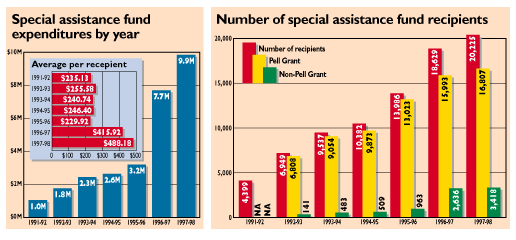
National Collegiate Athletic Association |
The NCAA News DigestMarch 29, 1999
NCAA Special Assistance Fund
Thousands of student-athletes continue to receive help annually from the NCAA's special assistance fund. The fund has increased from $1 million in its first year (1991-92) to $9.9 million in 1997-98. The number of recipients also is rising, having grown from 4,399 in the first year to 18,629 in 1996-97 to 20,225 last year. The average grant per recipient was $488 in 1997-98. Special assistance funds may be awarded to student-athletes who are Pell Grant-eligible or who have demonstrated financial need. Student-athletes who may otherwise be unable to afford basic necessities such as clothing, basic supplies for classes, a trip home for a family emergency or medical care not provided by an insurance program may receive help from the special assistance fund.
LITIGATIONMembership receives update about Prop 16 decision The Divisions I and II memberships have received a bulletin that addresses questions that have developed in the wake of a court ruling overturning Proposition 16. The document was developed by the membership services staff and was mailed March 18. U.S. District Judge Ronald L. Buckwalter ruled March 8 in favor of four African-American student-athletes who challenged the NCAA's use of standardized test score cutoffs to determine initial eligibility in Division I. Buckwalter later denied the NCAA's motion to stay the ruling and also declined to narrow the ruling so that it would apply only to the named plaintiffs. The Association sought a stay of the ruling March 18 from the U.S. Court of Appeals for the Third Circuit. The NCAA also has appealed Buckwalter's ruling, challenging both the decision on Proposition 16 and Buckwalter's claim that the NCAA is a recipient of federal funds. Staff contact: Elsa Kircher Cole.
OFFICIAL BALLWilson football chosen for championships, NCAA Football The NCAA has named Wilson Sporting Goods Co. as the supplier of the official ball of its football championships and NCAA Football. The agreement will be effective beginning in 1999 and will run through 2003. It extends to NCAA football championships in Divisions I-AA, II and III. There will be three patterns from which to choose: the F1001, which is the same pattern and size as the National Football League game ball; the F1005, a ball that is said to be easier to grip and throw (for players with smaller hands); and the new F1004, a slightly narrower ball, which is the same pattern as the Wilson TD football and is the Wilson ball of choice for high schools. Staff contact: C. Dennis Cryder.
BASEBALL BATSEaston agrees to indemnify against litigation involving injuries The NCAA has reached agreement with Easton Sports, a nonwood-bat manufacturer, to indemnify NCAA member institutions and conferences against litigation involving injuries due to individuals being struck by batted balls propelled by Easton metal bats. The NCAA also is in negotiating with two other nonwood-bat manufacturers -- Hillerich & Bradsby and Worth -- regarding similar indemnification. In mid-January, the Executive Committee adopted performance standards for nonwood bats for the 1999 championships that decrease the maximum allowable diameter to 23/4 inches to 25/8 inches and the length-to-weight unit differential from five to three. In adopting the standards, the Executive Committee voted that such action would be contingent on the NCAA receiving indemnification from nonwood-bat manufacturers. In a related development, the NCAA Baseball Research Panel conducted its first meeting March 11-12 at Indianapolis. The panel met with representatives from selected baseball bat and ball manufacturers, independent scientists who have studied bat and ball performance, representatives from the Sporting Goods Man-ufacturers Association and a representative from the NCAA Baseball Rules Committee. Staff contacts: Stephen R. Hagwell.
STUDENT-ATHLETESDivisions I, II SAACs focus on major issues The Division I Student-Athlete Advisory Committee recently completed its work on a new initial-eligibility model while its Division II counterpart examined diversity issues. The Division I SAAC's initial-eligibility model provides what the committee believes to be an equally weighted combination of core grade-point average and test score. The committee submitted the model to the Division I Management Council and the Board of Directors for review. The Division II SAAC cited the need to increase diversity at the national committee level as well as on campus and conference SAACs. As part of a possible solution, the committee will recommend a change in the nomination process for filling vacancies on the national SAAC. Staff contacts: Janet Justus, Division I, and Lori Hendricks, Division II.
NCAA FOUNDATIONFoundation hires Peavey as new executive director The NCAA Foundation has selected Marion B. Peavey as its executive director. Peavey, vice-president for development and alumni relations at the University of Delaware, will direct all of the Foundation's fund-raising and development efforts. He also will oversee the management of the Foundation to ensure that funds are available to support present and projected needs. Peavey also has served as vice-president of development and university relations at the University of Alabama at Birmingham and at the University of Virginia.
|
